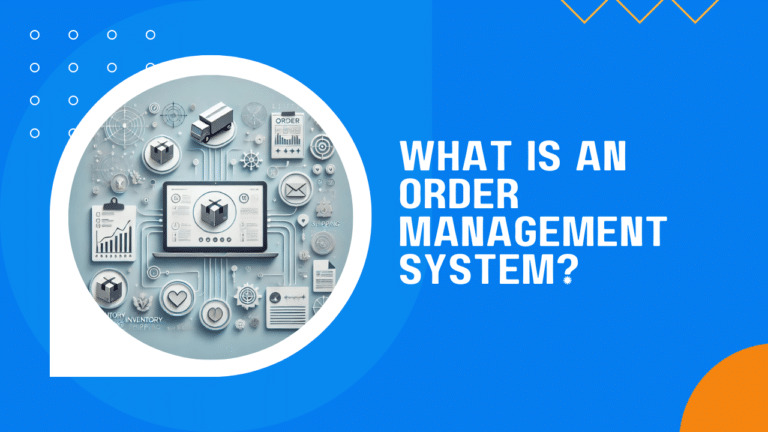Businesses need efficient tools to manage the increasing complexity of order fulfillment. This is where an Order Management System (OMS) steps in. An OMS is a software solution designed to centralize and automate the order processing cycle, from initial order placement to inventory management and shipping. By integrating these crucial tasks into a single platform, an OMS helps businesses reduce errors, improve order accuracy, and deliver a seamless customer experience.
For growing businesses, especially those managing orders across multiple sales channels, adopting an OMS is not just a matter of convenience—it’s a necessity. In this article, we’ll explore the key benefits of an OMS, how it works, and why implementing one can be a game-changer for your order fulfillment strategy.
What Is an Order Management System?
An Order Management System (OMS) is a centralized software platform that manages the entire lifecycle of an order—from the moment a customer places an order through to its processing, inventory management, and fulfillment. It streamlines operations by automating various stages of order handling, ensuring efficiency, accuracy, and consistency in both online and offline sales environments.
At its core, an OMS integrates critical business processes like inventory management, order processing, and shipping into a single unified platform. This reduces the need for manual data entry and minimizes errors, especially in high-volume or multi-channel businesses. Whether you’re selling through ecommerce platforms, retail stores, or marketplaces, an OMS ensures that each order is tracked, processed, and delivered on time.
For growing businesses, especially in the ecommerce space, an OMS is essential for managing increasing order volumes and ensuring customer satisfaction. By integrating with other systems like customer relationship management (CRM) tools, warehouse management systems (WMS), and shipping carriers, an OMS provides real-time insights into stock levels, order status, and delivery timelines.
Key Benefits of Using an OMS
Implementing an Order Management System (OMS) provides several benefits that can streamline operations and improve customer satisfaction. Here are some of the key advantages:
1. Improved Order Accuracy
One of the most significant benefits of using an OMS is the reduction of human errors during order processing. With automation, businesses can ensure that each order is handled consistently and accurately. The system automatically checks stock availability, updates inventory in real time, and verifies shipping details, ensuring that the right products are delivered to the right customers. This reduces issues like incorrect shipments, missed orders, or overselling, which can severely impact customer satisfaction.
2. Integrated Inventory Management
An OMS provides real-time visibility into inventory across multiple locations or sales channels. This integration helps businesses avoid stock outs and overstocking, ensuring that customers can place orders with confidence that items are in stock. By synchronizing with inventory systems, an OMS keeps track of products as they are ordered, returned, or restocked, helping businesses optimize their inventory levels and reduce carrying costs.
3. Faster Order Fulfillment
By automating key steps in the order process, such as order routing and shipping, an OMS speeds up fulfillment. Orders can be automatically assigned to the nearest fulfillment center or warehouse, reducing shipping times and costs. This automation not only increases efficiency but also improves the customer experience by ensuring faster deliveries.
4. Multichannel Order Management
Today’s ecommerce businesses often sell across multiple platforms, including their own websites, online marketplaces, and physical stores. An OMS simplifies multichannel order management by consolidating orders from various sources into one system. This unified approach ensures that no matter where a sale is made, the order is processed efficiently and accurately, providing a seamless experience for both the business and the customer.
By implementing an OMS, businesses can reduce manual processes, enhance operational efficiency, and ultimately increase customer satisfaction.
How an OMS Works
An Order Management System (OMS) simplifies and automates the order fulfillment process by managing the entire lifecycle of an order, from the moment it’s placed to when it reaches the customer. Here’s a breakdown of how an OMS typically works:
1. Order Processing
Once a customer places an order, the OMS initiates the process by verifying the availability of inventory. It checks stock levels, confirms payment, and ensures that all necessary customer information is correctly captured. The system then allocates the order to the appropriate fulfillment center or warehouse based on factors such as location, inventory availability, and shipping method. This real-time processing ensures that orders are quickly and efficiently routed for fulfillment, reducing delays and manual intervention.
2. Integration with Inventory and Shipping
An OMS integrates with various systems, including inventory management and shipping platforms, to provide a seamless fulfillment process. It updates inventory levels as orders are processed and tracks products across multiple locations or channels. The system also communicates directly with shipping providers, creating shipping labels and tracking information, and ensuring that orders are dispatched as soon as they are ready.
This integration allows businesses to automate and optimize shipping logistics, providing real-time tracking updates to both the business and customers. The OMS ensures that shipping details are accurate and compliant with carrier requirements, reducing shipping errors and improving delivery times.
3. Integration with Shipping, Logistics, and Third-Party Fulfillment
An OMS not only integrates with shipping platforms but also works seamlessly with third-party order fulfillment companies (3PLs). For businesses looking to outsource their warehousing and fulfillment processes, an OMS can automatically communicate with 3PLs, ensuring orders are processed and shipped efficiently.
When businesses choose to outsource to a 3PL provider, the OMS plays a crucial role in managing the flow of information between the business and the third-party provider. It updates inventory levels, sends order details directly to the fulfillment center, and tracks shipments, all while maintaining real-time transparency for both the business and the customer. This partnership allows businesses to scale operations without investing in their own warehousing or shipping infrastructure, all while maintaining full control over the customer experience through the OMS.
4. Returns Management
In addition to processing orders, an OMS also simplifies the handling of returns, a critical aspect of customer service. The system integrates reverse logistics, automating the process of issuing return labels, tracking returned items, and updating inventory once returned items are processed. By consolidating all aspects of returns within the order management process, businesses can manage refunds, exchanges, and restocking with greater efficiency, improving the overall customer experience.
By automating these critical functions—order processing, shipping, and returns—an OMS streamlines order fulfillment, reduces manual tasks, and ensures that businesses can meet customer expectations for fast and accurate service.
How an OMS Improves Customer Satisfaction
A well-implemented Order Management System (OMS) doesn’t just enhance internal operations; it also significantly improves the customer experience. Here are some key ways an OMS boosts customer satisfaction:
1. Transparency and Real-Time Order Tracking
Customers today expect to be informed throughout the entire order journey—from the moment they place an order until it arrives at their doorstep. An OMS provides real-time updates and visibility into each stage of the order fulfillment process. By integrating with shipping carriers, the system can send automated tracking details directly to customers, giving them full transparency on the status of their order. This added layer of visibility not only reduces anxiety for customers but also helps build trust and reliability.
2. Faster Issue Resolution
When a problem arises, such as a delayed order or a shipping error, customers want quick solutions. An OMS centralizes all order-related data, allowing customer service teams to easily access the information they need to resolve issues quickly. From order details and inventory levels to shipping statuses, every piece of information is available at a glance, enabling faster and more accurate responses to customer inquiries. This streamlined approach to customer service minimizes frustration and increases overall satisfaction.
3. Efficient Returns Management
The returns process can be a pain point for customers if not handled efficiently. An OMS simplifies and accelerates the returns process by automating return label generation, tracking return shipments, and updating inventory in real time once returns are processed. This makes it easier for customers to return or exchange products, improving their overall experience with the brand. A smooth, hassle-free returns process is essential for customer retention, and an OMS helps ensure that this process runs seamlessly.
Choosing the Right OMS for Your Business
Selecting the right Order Management System (OMS) is crucial for businesses looking to streamline operations and enhance customer satisfaction. With a variety of OMS solutions available, it’s essential to choose one that fits your specific business needs. Here are some key factors to consider when selecting the best OMS for your company:
1. Integration Capabilities
A good OMS should seamlessly integrate with your existing systems, including inventory management, ecommerce platforms, CRM tools, and shipping carriers. Look for an OMS that offers robust API integration, allowing you to connect with third-party applications and streamline your workflows. This ensures that your OMS serves as a central hub for all order-related processes, reducing the need for manual data entry and minimizing errors.
2. Scalability
As your business grows, so will your order volume and complexity. It’s important to choose an OMS that can scale with your business. Consider systems that can handle high transaction volumes, support multiple sales channels, and accommodate international shipping and fulfillment. A scalable OMS allows you to manage increasing demand without compromising on efficiency or customer service.
3. Real-Time Inventory Tracking
An OMS should provide real-time inventory visibility to help you avoid stock outs, overstocking, and missed sales opportunities. Make sure the system offers real-time updates on inventory levels across all locations and sales channels. This feature not only optimizes inventory management but also ensures that customers receive accurate stock information when placing orders.
4. Multichannel Support
If your business operates across multiple sales channels—such as online marketplaces, brick-and-mortar stores, and your own ecommerce site—your OMS must be capable of managing orders from all channels in one place. Look for a system that can integrate with platforms like Amazon, Shopify, eBay, and more, providing a unified order processing experience regardless of where the sale occurs.
5. Ease of Use
While features are important, the user experience should not be overlooked. An OMS should be intuitive and easy to navigate for your team. Look for systems with a clean user interface, straightforward reporting tools, and comprehensive support resources to ensure a smooth implementation process.
6. Cost and ROI
When choosing an OMS, it’s important to consider the total cost of ownership, including setup fees, monthly subscription costs, and any additional charges for integrations or customizations. However, you should also weigh this against the return on investment (ROI). A well-implemented OMS can lead to significant cost savings by reducing manual labor, increasing order accuracy, and speeding up fulfillment processes.
Conclusion
Investing in the right Order Management System can transform the way you manage your business’s orders, from improving internal efficiency to enhancing customer satisfaction. By considering factors such as integration capabilities, scalability, multichannel support, and cost, you can choose an OMS that not only meets your current needs but also scales with your business as it grows.







